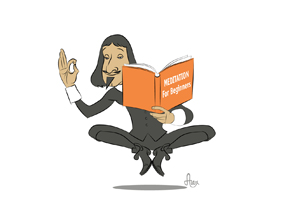
Your complimentary articles
You’ve read one of your four complimentary articles for this month.
You can read four articles free per month. To have complete access to the thousands of philosophy articles on this site, please
West Meets East
Meditating with Descartes
Karen Parham asks how close Western philosophy gets to Buddhism.
Why did René Descartes (1596-1650) name his famous treatise Meditations on First Philosophy? Broadly speaking, ‘to meditate’ means ‘to think deeply about something’ (OED). Although Descartes probably meant the word in this general sense, I would like to look at whether his method, and Western philosophy in general, has some correlation with meditation in the Eastern sense of the word. To do this I will consider the meditation techniques of Zen and of traditional Theravada Buddhism.
Peace of Mind

First let us consider whether Western philosophy aims for peace of mind.
The purpose of Western philosophising is to find solutions to profound questions, such as the meaning of life or the nature of mind, and every philosophical theory is an attempt at solving a philosophical problem. To develop such a theory might momentarily provide peace of mind.
The object upon which Western philosophers focus is the question they aim to answer, such as ‘What is truth?’ or ‘What is language?’. These questions may be a little like the koans that Zen Buddhists focus on during their meditations. Koans are paradoxical statements, parables, or questions that have no logical answer – a commonly cited koan is, “What is the sound of one hand clapping?” They require the student monk to disengage their reasoning faculties and instead turn to their intuition; to the non-rational. In this sense, koans cannot be solved, they can only be responded to. Arriving at an appropriate response to a koan can take days, months, or a lifetime. The Zen master knows from the student’s response whether they are ready to move on to another koan, and whether they have ‘seen the light’. Philosophical questions are like koans in that they confound the mind in having no absolute answers, and in that they are also questions philosophers can spend their lifetime answering. And when a ‘solution’ is found, the philosopher can feel euphoric and enlightened. However, there is an important difference: philosophers rely on their reason to answer their ‘ koans’. Philosophical koans are also presented in such a way as to suggest that there is a rational answer, whereas Zen koans are not. Philosophical answers will also have meaning and make sense to others, not just to the ‘meditator’. So, although philosophy does in a sense aim for peace of mind, it aims for it using a different technique to that of Zen Buddhists. Furthermore, its object of enquiry, the philosophical question, has an answer that is designed to appeal to others as well as satisfying the individual philosopher in question.
Descartes’ Koan
Let’s now consider Descartes in particular. Descartes’ philosophical koan in his Meditations is, “What can I know for certain?” At the start of his Meditations he explains how he reached a stage in his thought where he was no longer as certain of anything as he used to be. The senses can sometimes deceive, and as he says, “it is prudent never to trust completely those who have deceived us even once” (p.12). For all he knows in this state of uncertainty, it may even be the case that he has no body; that he’s just dreaming that he’s sitting by the fire writing out the Meditation. It could even be possible that one plus one does not actually equal two and an evil demon is deceiving him into thinking that it does. Perhaps he may not even exist? To achieve any peace of mind in this situation of radical doubt, Descartes needs to find something certain. The way he intends to find this is through an introspective exercise of reason.
If a Zen Buddhist were given “What can I know for certain?” as a koan, they would also be required to be introspective. The answer to a koan cannot be sought in the outside world. However, the response does not require the monk to make judgements, infer or conclude. Nevertheless, a monk may well respond to a koan in a number of ways: by being silent, by nodding, or by screaming; or they may respond by talking about something seemingly unrelated. Descartes, however, does none of this. His response to the question comes in the form of a conclusion reached deductively.
One type of logical deduction relies on a specific example being applied to a universal premise to reach a conclusion. For example:
All Buddhists meditate (universal premise)
Descartes is a Buddhist (specific example)
Therefore Descartes meditates (conclusion)
However, Descartes’ thought process about what he can be certain of (which he started in his previous work, the Discourse on Method) produces an incomplete argument: an enthymeme. An enthymeme is a deduction without the universal premise. His famous argument ‘I think therefore I am’ (p.17) is arguably of the form:
All thinking things exist (universal premise)
I am thinking (specific example)
Therefore I exist (conclusion)
According to this interpretation, Descartes assumes, but has not written, the universal premise that all thinking things exist. So some philosophers might class Descartes’ response – ‘I think therefore I am’ – to his koan as being merely intuitive.
Perhaps Descartes would have had more peace of mind if he had engaged with his Buddha-nature. He may then have realised the limits of his conceptual thought and trusted in just ‘being’.
Natural Light

Another Zen-like feature in Descartes’ Meditations is the ‘natural light’. Through what he calls ‘clear and distinct ideas’, the natural light presents truths to Descartes that cannot be doubted. Descartes’ general rule is that “whatever I perceive clearly and distinctly must be true” (p.24). Descartes uses the natural light of reason to conclude (among other things) that he exists, that God exists, that deceit is an imperfection, and that material objects do indeed possess the geometric and other mathematical properties he judges them to possess.
Zen Buddhists could also claim that the responses they receive from meditating on koans are clear and distinct ideas. That is the nature of ‘seeing the light’. Good responses to Zen koans must, by Descartes’ criterion, therefore be true. They may even be nearer the truth (if there is such a thing) than Descartes’ conclusion, because Descartes’ argument about relying on the natural light is circular. He believes that the natural light is reliable because God exists and does not deceive him about the natural light; yet Descartes needs the natural light to prove that God is not a deceiver… This natural light tells Descartes that deceit is an imperfection: therefore, God, who by definition is a perfect being, cannot deceive him about what the natural light tells him.
Descartes does not seem to have engaged his intuition properly here, and had he had a Zen Master he might have received a slap in the face (an interesting teaching tool often used by Zen masters) to awaken him.
Shifts in Consciousness
Like Descartes, Buddhists tend to be substance dualists, also believing that mind and matter are what constitute Ultimate Reality or Truth (paramattha). This claim is made for instance in the Abhidharma Pitaka, part of the important Buddhist scripture known as the Tipitaka (or Tripitaka). This section of the Tipitaka also stresses that there is no ‘I’ or individual person – as Hume also claimed in response to Descartes’ assumption that ‘he’ is doing the thinking. Hume believed that a unified self is an illusion and that there is only a bundle of perceptions. If the self really is an illusion, then meditation requires a shift in awareness in order for the meditator to realise Ultimate Truth.
Empiricists, who rely on experience as their source of knowledge, will not be interested in shifting their consciousness away from the evidence the world presents to them. Rationalists like Descartes, on the other hand, may well shift their consciousness away from the world of appearances when contemplating deduction, logic, mathematics and geometry.
Let’s consider what rationalists shift their consciousness towards before comparing it to the Buddhist mental shift. The rationalist will direct their attention towards something abstract – towards concepts or ideas. Descartes shifts his consciousness towards the idea of God, for example: an idea that he believes is innate. The idea he has in his mind is of an infinite and perfect being. This is quite different from the idea he has of himself. He makes mistakes, is subject to change, will one day cease to exist as an embodied thinking thing, and has trouble getting out of bed in time to teach philosophy to the Queen of Sweden. So Descartes is finite and imperfect. But Descartes’ natural light tells him that a cause must be equal to or greater than its effect (this is known as the causal adequacy principle). So the cause of the idea of God must be something either equal to the idea of God or greater than it. But what could be equal to or greater than the idea of a perfect being? The only possibility is that God must be the cause of the idea of God that Descartes has. So God exists.
Unfortunately, Descartes has not managed to shift his consciousness entirely. Indeed, he has not really managed to distance his thought from the external world at all, because his idea of God could quite easily be built from experience. He believes that the idea of God is innate. Yet if it were innate, everyone would possess it. However, as John Locke pointed out when criticising the concept of innate ideas, some people do not have any idea of God, and others have a different idea of God. Hume proposed a better origin for the idea of God: the mind transposes, combines, and enlarges ideas derived from sense impressions to create the idea. As Hume states, “the idea of God – meaning an infinitely intelligent, wise, and good Being – comes from extending beyond all limits the qualities of goodness and wisdom that we find in our own minds” – adding that these latter ideas are copied from sense impressions (An Enquiry Concerning Human Understanding, p.8). If Hume is right, then Descartes has been unsuccessful in actually distancing himself from the world of sense impressions.

He could have tried to shift his awareness further away from the world of appearances, as Theravada Buddhists do during samatha meditation. Samatha meditation involves focusing on the breath or some neutral object in order to achieve calmness, in preparation for a second type of meditation called vipassana, which aims to achieve insight. As the practitioner becomes more proficient they will experience profound states of absorption known as jhana s. Theravada Buddhists recognise eight jhanas. As the meditator progresses from one jhana to the next, they experience deeper levels of concentration, to the point that they have transcended time and space and even nothingness in their experience, and the meditator enters a realm of immateriality. In the sixth jhana the successful Buddhist will encounter boundless consciousness; in the seventh nothingness; and in the eighth neither perception nor non-perception. These are the realms of the infinite; of no-thing-ness and of non-dual awareness. The mind has here surpassed any idea of an infinite and perfect being; that idea would only be an obstacle to achieving enlightenment. In other words, for the Theravada Buddhist, the idea of God would be a distraction standing in the way of seeing the true nature of reality.
Isn’t this distraction exactly what happened to Descartes? So if he had been able to let go of his idea of God, he may have come to some deeper realisations… Then again, if he had done this, he may not have delivered a treatise so thought-provoking that it has kept Western philosophers busy ever since.
Western Philosophy In General
So Descartes is not really very Buddhist, but he did have the potential. If he had used the natural light without being distracted by the idea of God, maybe he would have got a little further towards enlightenment.
What can we say about Western philosophy in general? How far are its methods compatible with those of Buddhism?
Well, the aims of philosophy do not seem so far removed from the aims of Buddhism. Both philosophers and Buddhists want peace of mind; to rationalise does require a shift in consciousness; and philosophical questions do sometimes seem to resemble koans. The enlightened Zen Buddhist, however, can respond to any type of question, paradox, or unanswerable question using their method. The philosopher, on the other hand, has a different task. First, she needs to distinguish between reasonable and unreasonable questions before attempting to answer the reasonable ones in a systematic way. Once the right questions are asked, the philosopher is less likely to stumble into inconsistencies or make errors in reasoning. She can then let her rational faculties run wild in the hope of finding an answer; but should not fall into the trap of thinking that the answer will be the final say on the matter. The question of certainty cannot be a sound philosophical question in this mould, as Descartes has unintentionally demonstrated, since nothing in the realm of thought is certain; but in the realms beyond thought and ideas it may well be.
© Karen Parham 2019
Karen Parham lectures in Philosophy and Religious Studies for Warwickshire College Group, Leamington Spa.









